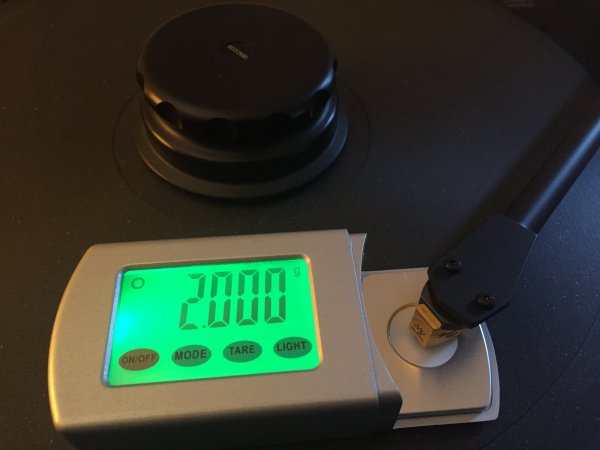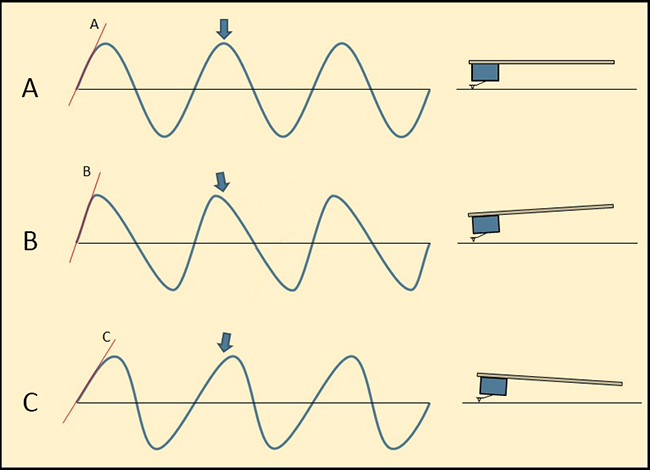I wrote this post a few months ago on a different sight in a discussion about VTA adjustments. I thought I would post it here to see if people have similar findings about the relationship between VTA and VTF.
I own the Audio Additives Stylus Force Gauge that Michael Fremer recommends in the Analog Planet link that Myles posted. I just calibrated it using the 5.0 gram weight and did some testing. As expected with my SME V-12 arm, if the VTF gauge is resting on the platter and not on varying thickness LPs, the VTF does change as I raise and lower my tonearm, changing the SRA.
I use a range of six arm height settings in 0.5mm increments from 16.0 mm to 18.5 mm covering the LPs in my collection. The Audio Additive scale is designed to test the VTF for an average thickness LP when placed on the platter. This is an approximation as we know that LPs vary in thickness by over 1mm (see table in this link: https://www.vinylengine.com/turntabl...p?f=41&t=93648) So, I set my arm at 17.25 mm, the average arm height for the LPs in my collection. I set the VTF, using the gauge, to 2.000g (see photo above) because this is centered within the range of 1.9 - 2.2g, according to the manual of my MySonicLabs Signature Gold cartridge. I then proceeded to measure the VTF at each of my arm height settings. Here are the results:
16.0mm: 2.019g
16.5mm: 2.011g
17.0mm: 2.005g
17.5mm: 1.993g
18.0mm: 1.988g
18.5mm: 1.970g
Interestingly, it is not precisely linear, but the scale is so sensitive/finnicky that each time I placed the stylus on it, the value changes by up to 0.003 or so. The range of VTF for my arm height settings is 0.049g (2.019-1.970g) or roughly 1/20th of a gram. If rounded to two places, it is 2.02g - 1.97g. This may or may not even be audible. The tracking force range of my cartridge (1.9 to 2.2g = 0.3g) is much greater at six times that 0.49g VTF range when I raise and lower my arm. And remember, this is with a fixed stylus height because the VTF gauge is sitting on the platter, not moving up and down with different record thicknesses. Arm height changes often correspond to different record thicknesses (if the original cutting angle is the same), but not always, and if the arm height increases by the same amount as the record thickness increases, VTF does not change at all. So, this change in VTF is within a 1/6 band in the center of my cartridge's recommended tracking force range, and even less when taking into account that the stylus is actually moving up or down as the LP thickness changes, causing even less change in VTF.
In real use, the VTF range with my varying arm heights may be within a much smaller band of the recommended tracking force range of my cartridge. Because the VTF gauge height is an approximation, the stylus on my thinnest LPs will be measured closer to the platter, and the arm will be much lower. Same with the thickest LPs, only in reverse. So, if one removes the two extreme cases of the 16.0mm and 18.5mm arm heights because the arm will be lower with thin LPs and higher with thick LPs, then the VTF range is only 2.011g - 1.988g or a 0.023g range. This is 13 times less than the tracking force range of my cartridge and within a tiny band of 23/1000 of a gram.
The LP thickness chart indicates that a 110g LP is 1.0mm thick and a 200g LP is 2.0mm thick, roughly. That is a range of 1.0 mm in typical LP thicknesses. However, my arm height changes cover a greater range of 2.5mm. So, I am raising and lowering my arm more than the differences in the record thicknesses in my collection. Either, the cutting head angles are all roughly the same and I am over adjusting my SRA settings by ear, or this increased arm height range reflects the varying cutting head angles in my LP collection. It could also be a combination of the two.
Fremer wrote that a 1mm change in arm height with a 9" arm roughly equals 0.25 degrees of SRA. My 12" is even less, say 0.2 degrees of SRA. So, my 2.5mm range in arm height corresponds to roughly a 0.5 degree of SRA change. (0.2 X 2.5 = 0.5). It is easy for me to imagine the cutting head angles vary in my records by 1/2 a degree or more. If Fremer recommends an average SRA setting of 92 degrees, a 1/2 degree variation means an SRA range of 91.75 to 92.25 degrees. This seems certainly possible. These numbers are small.
When VTF is measured at a fixed point like from the stationary scale resting on the platter, it does change very slightly with changes in arm height. However, if one considers that the stylus tip is also moving slightly up or down with changes in record thickness as one adjusts arm height, VTF values change even less, or not at all, as when the arm tube angle does not change with adjustments in height.
It is astonishing to me that with numbers this small, minor adjustments in SRA are audible.
I own the Audio Additives Stylus Force Gauge that Michael Fremer recommends in the Analog Planet link that Myles posted. I just calibrated it using the 5.0 gram weight and did some testing. As expected with my SME V-12 arm, if the VTF gauge is resting on the platter and not on varying thickness LPs, the VTF does change as I raise and lower my tonearm, changing the SRA.
I use a range of six arm height settings in 0.5mm increments from 16.0 mm to 18.5 mm covering the LPs in my collection. The Audio Additive scale is designed to test the VTF for an average thickness LP when placed on the platter. This is an approximation as we know that LPs vary in thickness by over 1mm (see table in this link: https://www.vinylengine.com/turntabl...p?f=41&t=93648) So, I set my arm at 17.25 mm, the average arm height for the LPs in my collection. I set the VTF, using the gauge, to 2.000g (see photo above) because this is centered within the range of 1.9 - 2.2g, according to the manual of my MySonicLabs Signature Gold cartridge. I then proceeded to measure the VTF at each of my arm height settings. Here are the results:
16.0mm: 2.019g
16.5mm: 2.011g
17.0mm: 2.005g
17.5mm: 1.993g
18.0mm: 1.988g
18.5mm: 1.970g
Interestingly, it is not precisely linear, but the scale is so sensitive/finnicky that each time I placed the stylus on it, the value changes by up to 0.003 or so. The range of VTF for my arm height settings is 0.049g (2.019-1.970g) or roughly 1/20th of a gram. If rounded to two places, it is 2.02g - 1.97g. This may or may not even be audible. The tracking force range of my cartridge (1.9 to 2.2g = 0.3g) is much greater at six times that 0.49g VTF range when I raise and lower my arm. And remember, this is with a fixed stylus height because the VTF gauge is sitting on the platter, not moving up and down with different record thicknesses. Arm height changes often correspond to different record thicknesses (if the original cutting angle is the same), but not always, and if the arm height increases by the same amount as the record thickness increases, VTF does not change at all. So, this change in VTF is within a 1/6 band in the center of my cartridge's recommended tracking force range, and even less when taking into account that the stylus is actually moving up or down as the LP thickness changes, causing even less change in VTF.
In real use, the VTF range with my varying arm heights may be within a much smaller band of the recommended tracking force range of my cartridge. Because the VTF gauge height is an approximation, the stylus on my thinnest LPs will be measured closer to the platter, and the arm will be much lower. Same with the thickest LPs, only in reverse. So, if one removes the two extreme cases of the 16.0mm and 18.5mm arm heights because the arm will be lower with thin LPs and higher with thick LPs, then the VTF range is only 2.011g - 1.988g or a 0.023g range. This is 13 times less than the tracking force range of my cartridge and within a tiny band of 23/1000 of a gram.
The LP thickness chart indicates that a 110g LP is 1.0mm thick and a 200g LP is 2.0mm thick, roughly. That is a range of 1.0 mm in typical LP thicknesses. However, my arm height changes cover a greater range of 2.5mm. So, I am raising and lowering my arm more than the differences in the record thicknesses in my collection. Either, the cutting head angles are all roughly the same and I am over adjusting my SRA settings by ear, or this increased arm height range reflects the varying cutting head angles in my LP collection. It could also be a combination of the two.
Fremer wrote that a 1mm change in arm height with a 9" arm roughly equals 0.25 degrees of SRA. My 12" is even less, say 0.2 degrees of SRA. So, my 2.5mm range in arm height corresponds to roughly a 0.5 degree of SRA change. (0.2 X 2.5 = 0.5). It is easy for me to imagine the cutting head angles vary in my records by 1/2 a degree or more. If Fremer recommends an average SRA setting of 92 degrees, a 1/2 degree variation means an SRA range of 91.75 to 92.25 degrees. This seems certainly possible. These numbers are small.
When VTF is measured at a fixed point like from the stationary scale resting on the platter, it does change very slightly with changes in arm height. However, if one considers that the stylus tip is also moving slightly up or down with changes in record thickness as one adjusts arm height, VTF values change even less, or not at all, as when the arm tube angle does not change with adjustments in height.
It is astonishing to me that with numbers this small, minor adjustments in SRA are audible.



